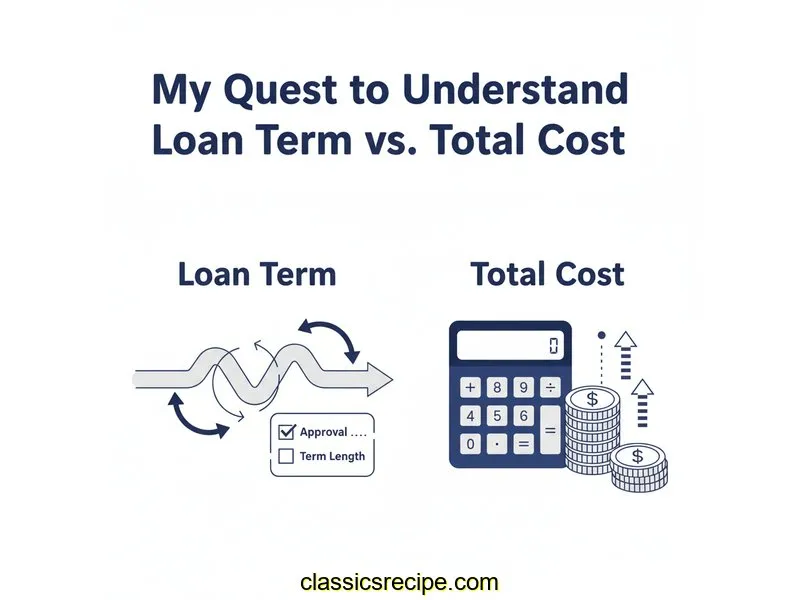
Auto Loan Calculator
Calculate payments over the life of your Loan
Home Blog Privacy Terms About Contact
Calculate payments over the life of your Loan
Home Blog Privacy Terms About ContactPublished on October 14, 2025

My journey into understanding personal finance calculations started with a simple, nagging question. I was playing around with an online loan calculator, just plugging in numbers to see how they worked, when I noticed something that felt completely backwards. I was looking at a hypothetical loan and saw that if I stretched the payments out over a longer period, the monthly payment went down. That part made sense. But then I saw another number—"Total Interest Paid"—and it went up. A lot.
How could a "cheaper" monthly payment result in me paying thousands of dollars more? It felt like a riddle. My brain was stuck on the idea that a smaller number each month must be better. I thought I was missing a key piece of the puzzle, some hidden fee or complex formula. The numbers were right there on the screen, but the story they were telling just didn't connect for me.
This wasn't about trying to find the "best" loan or make a financial decision. My goal was purely educational. I wanted to lift the hood and understand the engine of loan math. Why did changing one variable—the loan term—have such a dramatic and, to me, counterintuitive effect on the total cost? It was this specific question that sent me down a path of discovery, determined to understand the relationship between time, payments, and the real cost of borrowing.
I decided to document what I found, not as an expert, but as someone learning in real time. This is my attempt to explain the calculations and share the "aha" moments I had along the way. Please remember, this is about understanding how calculations work, not financial advice. My aim is simply to share the clarity I found by digging into the numbers.
My initial confusion really took root when I started comparing two specific scenarios side-by-side. I imagined I needed a loan for a hypothetical project, let's say for **$13,850**. I found a calculator and entered an interest rate of **6.7%**. Then, I started playing with the "Loan Term" field. This is where my brain started to short-circuit.
First, I set the term to 60 months (5 years). The calculator spit out a monthly payment of around $271.86. My immediate thought was, "Okay, that seems manageable." In my mind, this was the key number. I then decided to see what would happen if I paid it off faster, so I changed the term to 36 months (3 years). The new monthly payment was **$426.51**. My gut reaction was to recoil. That's over $150 more each month! Clearly, the 5-year option was the "cheaper" one, right?
This is where I made my big mistake. I was so focused on the monthly payment figure that I completely ignored the other outputs the calculator was providing. I saw the fields for "Total Principal Paid," "Total Interest Paid," and "Total Cost," but I mentally dismissed them as secondary details. I was comparing two options based on a single, incomplete piece of data.
For a while, I was genuinely frustrated. I thought maybe the calculator was broken or I was using it wrong. I tried different websites, but they all showed the same thing. The longer term always had a lower monthly payment but a higher total interest cost. I couldn't wrap my head around the "why." My flawed logic was that since the interest rate (6.7%) was the same in both cases, the cost should be proportional. I failed to grasp the crucial role that time plays in the calculation of interest.
The breakthrough came when I forced myself to stop looking at the monthly payment. I decided to treat it like a science experiment, focusing on every single variable and output to see how they interacted. I opened a simple spreadsheet and decided to manually log the results from the calculator, creating my own comparison chart. This simple act of writing the numbers down myself forced me to actually see them.
I took my initial scenario—the $13,850 loan at 6.7%—and meticulously recorded the outputs for both the 36-month and 60-month terms. I put them right next to each other. For the 36-month loan, the total interest was **$1,504.36**. For the 60-month loan, the total interest was **$2,461.60**. Suddenly, seeing it in black and white, the difference of nearly $1,000 was impossible to ignore. It was the "Total Interest Paid" field that held the key. It was the price tag for time. The lower monthly payment wasn't cheaper; it was just spread out over a longer period, allowing more interest to accumulate along the way.
My biggest "aha moment" was realizing that interest is calculated on the remaining balance of the loan, month after month. It's not a one-time calculation. When you have a longer loan term, like 60 months, you are paying down the principal more slowly. This means the balance stays higher for longer, and so each month, the interest calculation is based on a larger number.
Think of it this way: with a 36-month loan, you have 36 instances where interest is calculated. With a 60-month loan, you have 60 instances. That's 24 extra months for interest to accrue. Even though each monthly payment is smaller, a larger portion of those early payments goes toward interest because the principal balance is still so high.
The final piece of the puzzle fell into place when I clicked the "Show Amortization Schedule" button on the calculator. This was a game-changer. I could see, month-by-month, exactly how much of my payment was going to interest and how much was going to principal. For the 60-month loan, I saw that in the first month, a huge chunk of the $271.86 payment went to interest. But by the last few months, almost the entire payment was going to principal.
Comparing the 36-month and 60-month schedules side-by-side was incredibly illuminating. The 36-month loan attacked the principal so much more aggressively from the start. This visual representation proved what the numbers were telling me: a shorter term reduces the principal faster, giving the interest less time and a smaller balance to feed on.
To make sure I truly understood, I ran a completely different scenario. This time, I imagined a **$19,200** loan with a **7.2%** interest rate. I compared a 48-month term against a 72-month term. Just as I now expected, the 72-month loan had a much lower monthly payment (around $328 vs. $462), but the total interest paid was drastically higher ($4,465.68 vs. $3,007.20). I finally got it. The calculation wasn't a mystery anymore; it was a predictable relationship between variables.

This entire exploration was incredibly empowering. I went from being confused by a calculator to understanding the logic behind its results. It wasn't about making a financial choice, but about gaining literacy in the language of loans. Here are the key calculation lessons that stuck with me:
As I went through this process, I kept asking myself some basic questions. Here are the answers I pieced together, which might be helpful if you're on a similar learning journey.
The term determines the number of times interest is calculated. A 5-year (60-month) loan will have interest calculated 60 times on its declining balance, while a 3-year (36-month) loan will only have it calculated 36 times. Those extra 24 months of interest calculations on a longer loan lead to a higher total interest cost, even if the rate is identical.
A lower monthly payment is usually achieved by extending the loan term. While it makes each individual payment smaller, it means you're paying for a longer duration. This extended period allows more total interest to accumulate over the life of the loan. The true "cost" is the total interest paid, not the size of the monthly payment.
The most important field for understanding the real cost of borrowing is "Total Interest Paid." This number represents the amount you are paying the lender on top of the money you borrowed. The "Total Cost of Loan" (or "Total Repayment") is also critical, as it shows the principal plus all the interest combined.
An amortization schedule is a powerful educational tool. Use it to see the breakdown of each payment. Notice how in the early months, a large portion of your payment covers interest. As you progress, more and more of your payment goes toward reducing the principal. This visualization helps you understand why paying off a loan faster saves you money on interest.
My journey to understand the relationship between loan term and total cost was a huge turning point for me. My biggest takeaway was learning to look beyond the surface number—the monthly payment—and dig deeper into the numbers that tell the whole story, especially the total interest paid. It transformed the loan calculator from a confusing black box into a transparent educational tool.
It showed me that understanding financial math isn't about being a genius; it's about curiosity and a willingness to break down the concepts piece by piece. Playing with the variables, seeing how they affect each other, and visualizing the results with tools like an amortization schedule made all the difference. I feel more confident now, not in making decisions, but in simply understanding the mechanics of how it all works.
I encourage anyone who feels intimidated by these topics to simply start playing with the numbers in a calculator. Ask "what if?" What if the term is longer? What if the rate is higher? Each click can reveal another layer of understanding. It’s a powerful way to build your own financial literacy from the ground up.
This article is about understanding calculations and using tools. For financial decisions, always consult a qualified financial professional.
Disclaimer: This article documents my personal journey learning about loan calculations and how to use financial calculators. This is educational content about understanding math and using tools—not financial advice. Actual loan terms, rates, and costs vary based on individual circumstances, creditworthiness, and lender policies. Calculator results are estimates for educational purposes. Always verify calculations with your lender and consult a qualified financial advisor before making any financial decisions.
